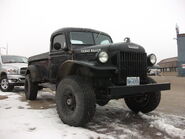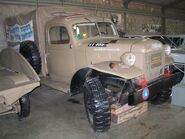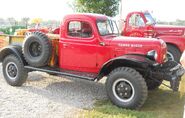 | |
| Manufacturer | Dodge |
|---|---|
| Parent company | Chrysler Group |
| Assembly | USA |
The Dodge Power Wagon was a four wheel drive pickup truck produced from 1945 through 1980. This early version was based on a military truck and is a predecessor to the many four wheel drive pickups in use today.
History[]
The Dodge Power Wagon was introduced in 1946. It was based on the 3/4-ton Army truck's chassis with a civilian cab and a purpose designed 8-foot cargo box. It had a 126 inch (3,200 mm) wheelbase chassis and featured the 230 cubic-inch flat head six engine, a two-speed transfer case, a 4-speed transmission with a power take off opening which would send power to the front and back of the truck for operating auxiliary equipment and 9.00/16-8 ply tires on 16X6.50 inch 5-stud wheels. In 1961 the 230 was replaced with the 251 cubic-inch flat head six. The nominal one-ton rated Power Wagon's gross vehicle weight rating (GVWR) was 8,700 pounds. Its maximum payload was 3,000 pounds. Big-block 383 V8 engines became an option starting in 1967. From 1961 to 1971 the body was called the "sweptline," then transitioned to a more modern body image from 1972 through 1980 with varied grilles and paint schemes. In 1975 the 4-wheel drive became full-time with a 2-speed transfer case; this was changed back to part-time 4-wheel drive in 1980 due to the energy crisis. A huge boost in sales followed the 1974 release of the extended "Club Cab," popular with families and camper towing. The 4-door "Crew Cab" was far less common and is quite desirable to collectors for restoration. Utility and function was unmatched by few competing models, as the towing, payload, and snow plowing capacity of the Power Wagon equipped with "Dana 60" 8-lug axles was very popular with municipal and regional road crews.
The Power Wagon was sold through the 1980 model year. A number of engineering and styling improvements were made over the years, but the basic package remained surprisingly constant throughout its life and underwent one last major body change in 1972.
The first light-duty Power Wagons came out in 1957 with the introduction of the W100 and W200 pickups (beginning in 1957 1/2-ton 2WDs were D100s and 4WDs were W100s). These trucks featured conventional cabs and front sheet metal and the cargo boxes used on the 2WD models. Their 4WD mechanical components—axles, transfer cases and transmissions—were sourced from outside manufacturers. Chrysler Corporation owned the New Process Gear Company, the manufacturer of all the transfer cases used in the industry and many of the light-duty truck transmissions.
A one-ton W300 light-duty/civilian type Power Wagon was released in 1958. For the next ten years the Power Wagon lineup consisted of the "military-type" W300M, and the W100, W200, and W300 "civilian-type" Power Wagons. Standard models included pickups and chassis cabs only. 1957 Through 1966, W100 Power Wagon Town Panels and Town Wagons were also standard models. In 1961 a W200 Crew Cab pickup was added to the line.
The two-ton W500 Power Wagon (only a chassis cab was built) was introduced in 1956 as the C3-HW, and lasted through the 1971 model year. This was replaced in 1972 with the W600 (also cab and chassis only), which was produced until 1977, when all Dodge medium-duty models were discontinued. To compensate for the loss of the medium-duty W600 a new W400 chassis cab was introduced in 1977.
The Power Wagon nameplate was discontinued in 1981 with the introduction of the Dodge Ram, with the four-wheel-drive models being sold under the "Power Ram" nameplate through 1993. Early 1990s models saw the addition of an optional 6-cylinder Cummins Turbo Diesel engine.
2005–present[]
For 2005, Dodge resurrected the Power Wagon name on a version of the Dodge Ram. It is a special off-road version of the Dodge Ram 2500 with a 5.7L Hemi V8 as the only engine option. Specialties of the model include: electronically controlled locking differentials (front and rear), an electronically-disconnecting sway bar (front and rear), an integrated 12,000 pounds (5,400 kg) Warn winch, clearance lights, black fender flares, 17 inches (43 cm) forged wheels, Power Wagon badging (doors & tailgate), larger 33 inches (84 cm) BF Goodrich All Terrain T/A tires, and an overall increase in ride height with 40 millimetres (1.6 in) Bilstein Monotube Gas Charged Shocks raising the overall height to 80.6 inches (2.05 m).
Interior configurations remain similar to standard production Ram 2500 models. Six speed manual transmissions were standard, with automatic transmission optional. The configuration was only available as a regular cab with 8 feet (2.4 m) bed (chassis) or a Quad Cab with the 6.5 feet (2.0 m) bed through 2008. In 2009, the Power Wagon is only available as a Quad Cab Short Bed model, and there is no manual transmission available.
Weight ratings:
- GVWR - 8510 lb
- GCWR - 17,000 lb
- GAWR (front) - 4500 lb
- GAWR (rear) - 6140 lb
- Max payload - 2,250 lb
- Max towing - 10,600 lb
See also[]
- CUCV
- Dodge WC series
- Dodge W-series/Power Ram
- List of Dodge automobiles
| This page uses some content from Wikipedia. The original article was at Dodge Power Wagon. The list of authors can be seen in the page history. As with Tractor & Construction Plant Wiki, the text of Wikipedia is available under the Creative Commons by Attribution License and/or GNU Free Documentation License. Please check page history for when the original article was copied to Wikia |




